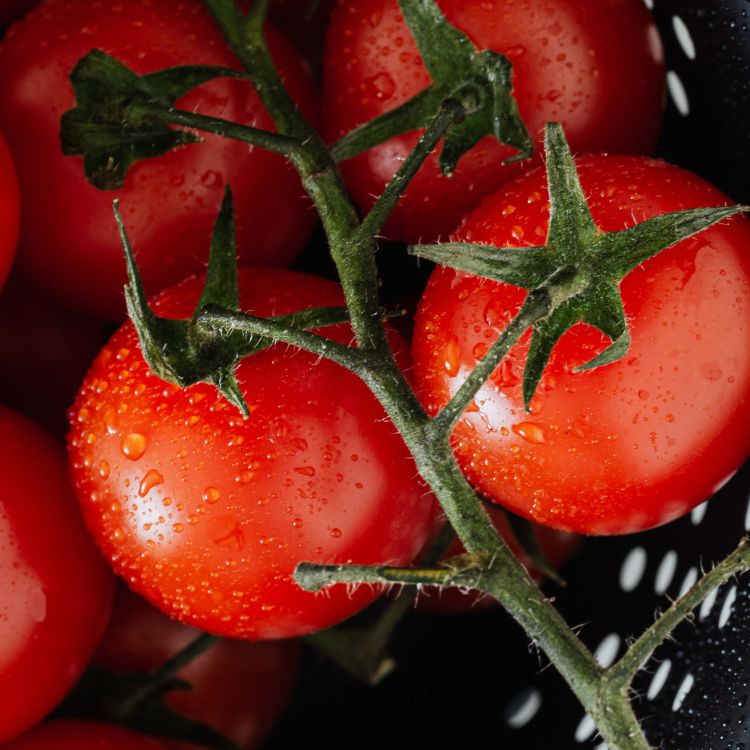
Key Takeaways
Selecting the right tomato variety for your climate and taste preferences is crucial.
Tomatoes thrive in full sun, requiring at least 7-8 hours of direct sunlight daily.
Planting tomato seedlings deeply encourages a strong root system for better nutrient uptake.
Consistent watering is key to preventing common tomato issues like blossom-end rot.
Using organic compost and mulch can boost plant health and yield without chemicals.
Unlock the Potential of Your Tomato Patch
Gardening isn’t just about putting plants in the soil—it’s about nurturing life and watching it thrive. And when it comes to tomatoes, a little know-how goes a long way. Stick with me, and you’ll discover the secrets to growing tomatoes that are the envy of the neighborhood.
Choosing the Ideal Variety for Your Garden
Before you even get your hands dirty, let’s talk varieties. You wouldn’t wear a parka in the desert, right? Similarly, you want to choose a tomato variety that suits your climate. If you’re in a cooler region, seek out varieties known for their cold tolerance. Warm climate dwellers should look for heat-tolerant types. Here’s the scoop:
For cooler climates: Think ‘Early Girl’ or ‘Glacier’—varieties that can handle a bit of chill.
For warmer climates: ‘Heatmaster’ and ‘Solar Fire’ are your go-to tomatoes, bred to withstand the heat.
For taste: Heirloom varieties like ‘Brandywine’ and ‘Green Zebra’ are unbeatable in flavor.
Most importantly, consider what you love. Whether it’s the sweetness of cherry tomatoes or the meatiness of a ‘Beefsteak’, grow what you’ll enjoy eating!
Decoding the Sunlight Puzzle
Tomatoes are sun worshipers. They crave light like kids crave candy. So, give them what they want: a spot in your garden that gets full, glorious sun for at least 7 to 8 hours a day. This isn’t just about getting them to grow; it’s about getting the best flavor out of every tomato. Without enough sun, they just won’t be as sweet or as juicy. Discover more about harnessing solar power for sustainable gardening practices to optimize your tomato cultivation.
Secret #1: Perfecting the Planting Process
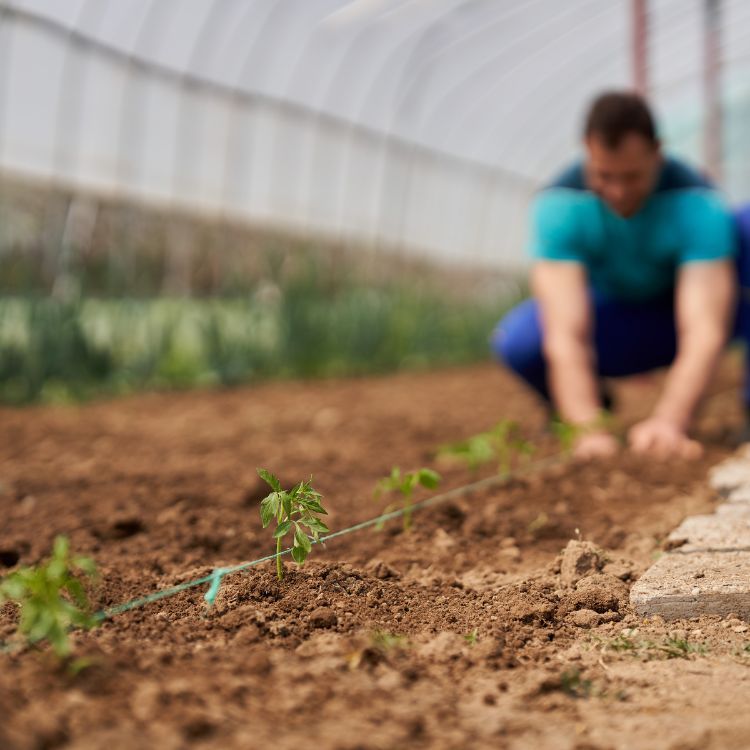
Now, let’s get those tomatoes in the ground. But not just any old way—we’re going to do it with a twist that sets you up for success.
The Depths of Success: Planting Deeply
Tomatoes have a secret superpower: their stems can grow roots. That’s why planting them deep is like giving them a turbo boost. Dig a hole deep enough so that two-thirds of the plant is underground. Strip off the lower leaves, and pop your tomato plant in. The buried stem will sprout extra roots, making for a stronger, more drought-resistant plant.
Spacing Out: Room to Grow
Tomatoes need room to breathe. Crowding them is like stuffing too many clothes in your drawer—nothing good comes of it. Give them space, about 24 to 36 inches apart. This way, air can circulate, reducing the risk of disease, and your tomatoes have room to stretch out their roots.
Secret #2: Soil and Nutrition Mastery
Think of soil as the tomato’s dining room. You want it to be a five-star experience. That means rich, nutritious, and well-draining. Here’s how to make that happen: for more in-depth guidance, explore these tips for growing tons of tomatoes.
Start with a soil test—this will tell you what your soil is lacking. Then, amend accordingly. A balanced meal for your tomatoes includes plenty of organic matter like compost, which provides a slow release of nutrients, and a balanced fertilizer to give them a little extra oomph.
Compost: Works like a charm for adding both nutrients and beneficial microorganisms.
Fertilizer: Choose an organic blend with equal parts nitrogen, phosphorus, and potassium.
Remember, too much of a good thing can be bad. Over-fertilizing can lead to lush leaves but few fruits.
Testing and Amending for Prime Growth
Before you plant, get to know your soil like you know your favorite pair of jeans. Test it to see what it’s made of—its pH, nutrient levels, and texture. Then, tailor it to meet the needs of your tomatoes. Add lime to raise pH or sulfur to lower it. Mix in organic matter to improve texture and fertility.
Organic Composts and Fertilizers
Why go organic? Because it’s like choosing fresh, home-cooked meals over fast food for your plants. Organic compost enriches the soil, and organic fertilizers ensure your tomatoes get all the nutrients they need without the harsh chemicals. Plus, they’re better for the environment and for the critters that live in your garden.
Secret #3: Watering Wisely
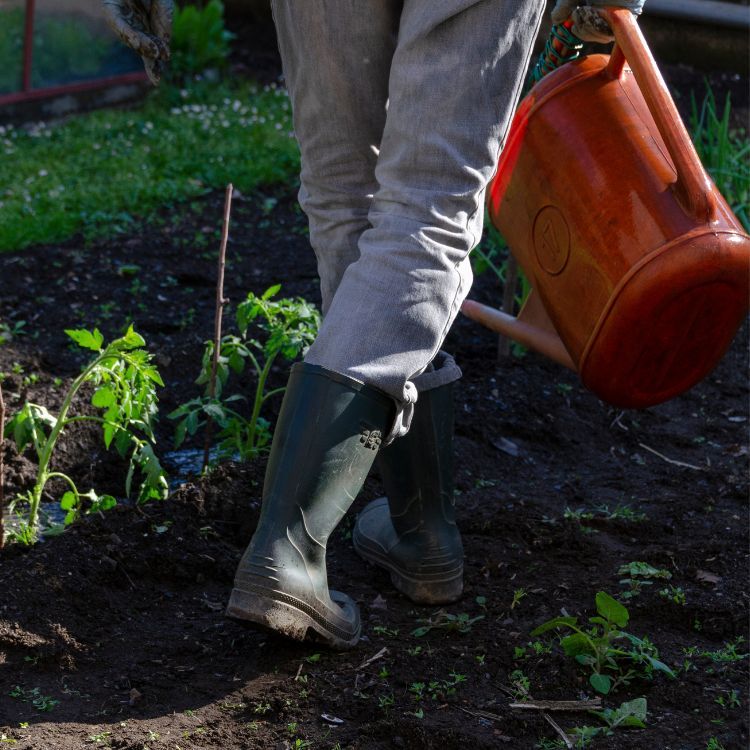
Water is to plants what tea is to a good chat – essential. But with tomatoes, it’s not just about quantity; it’s about consistency. Irregular watering can lead to a host of problems, like cracked fruits and blossom-end rot. Here’s the trick: water deeply and regularly, aiming for about 1 to 2 inches per week. The goal is to keep the soil evenly moist, not soggy or dry.
Use a mulch layer to help retain soil moisture and reduce the need for frequent watering. And always water at the base of the plant to keep the leaves dry, which helps prevent disease. Remember, early morning is the best time to water, as it allows the foliage to dry out during the day.
When to Water and How Much
Water your tomatoes in the morning, and give them a good soak. You want the water to reach deep into the soil to encourage the roots to grow down, not just skim the surface. If you’re not sure when to water, stick your finger into the soil; if it’s dry an inch down, it’s time to water.
Tricks to Maintain Consistent Moisture Levels
Consistency is king in the realm of watering. To maintain even moisture levels:
Use a drip irrigation system or soaker hoses to deliver water directly to the roots.
Check the soil regularly, and adjust your watering schedule based on rainfall and temperature.
Consider using a rain gauge to keep track of how much water your garden is receiving naturally.
Secret #4: Battling Pests and Diseases
Tomatoes can attract a few unwanted guests, like aphids and hornworms, not to mention diseases like blight. But don’t fret; there are ways to fight back naturally. Start with healthy, disease-resistant varieties. Keep your garden clean, removing any diseased leaves or debris that could harbor pests.
Encourage beneficial insects, like ladybugs and lacewings, by planting flowers they love. And if you need to, use organic insecticides sparingly. Remember, the best defense is a good offense, so keep your plants healthy, and they’ll be less likely to succumb to pests and diseases.
Natural Strategies for Pest Control
Here’s the lowdown on keeping pests at bay:
Introduce beneficial insects that prey on common tomato pests.
Plant marigolds or basil near your tomatoes; their scent can deter bugs.
Handpick larger pests like tomato hornworms off your plants.
Preventative Measures Against Common Diseases
Rotate your crops each year to prevent disease build-up in the soil. Make sure there’s good air circulation around your plants to keep the foliage dry. And choose resistant varieties when possible. If you do spot a problem, act fast to remove and destroy affected plant parts.
Secret #5: Staking, Training, and Pruning
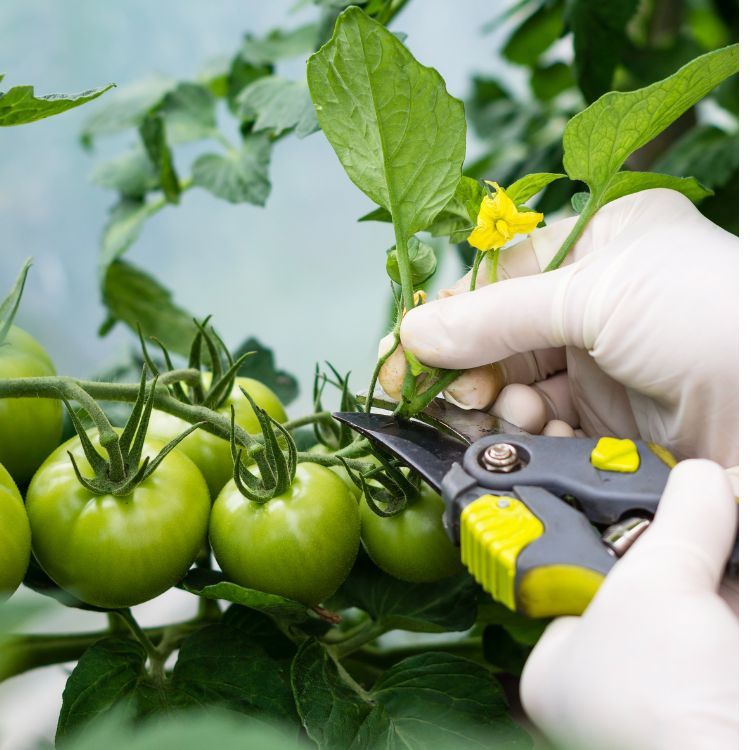
Think of staking and training your tomatoes as teaching them good posture. It keeps them off the ground, reducing disease and making it easier to harvest. You can use cages, stakes, or trellises – just make sure they’re in place when you plant to avoid damaging the roots later on.
Pruning is like giving your tomatoes a haircut to help them grow better. Remove the suckers, those little shoots that sprout in the leaf joints, to encourage more fruit and less foliage. But don’t overdo it; tomatoes need some leaves for photosynthesis and sun protection.
The Art of Tomato Trellising
String, stakes, or cages – trellising your tomatoes helps them reach for the sky. It’s not just about keeping them off the ground; it’s about maximizing sun exposure and air flow. Choose a method that works for you and your garden, and watch your tomatoes climb to new heights.
Pruning for Prosperity: Suckers and Leaves
Pruning is the secret sauce for bountiful tomato harvests. Here’s how:
Pinch off the suckers early when they’re small. You can leave a few on determinate varieties, but indeterminate types benefit from regular pruning.
Remove any leaves touching the ground to prevent disease. And don’t be afraid to thin out a few leaves to improve air circulation, especially in humid climates.
Secret #6: Mulching for Moisture, Warmth, and Weed Suppression
Mulch is like a cozy blanket for your tomato plants. It keeps the soil warm, retains moisture, and suppresses weeds. Organic mulches like straw or shredded leaves also add nutrients to the soil as they break down. Apply a 2-3 inch layer around your plants, being careful not to pile it up against the stems. For more information on eco-friendly planting strategies, check out our detailed guide.
Not all mulches are created equal, though. Black plastic can warm the soil and control weeds, but it doesn’t add organic matter to the soil. Choose the right mulch for your garden goals and conditions.
Choosing the Right Mulch for Tomatoes
When it comes to mulching tomatoes, you’ve got options:
Straw is great for keeping the soil cool and moist.
Grass clippings add nitrogen as they decompose.
Shredded leaves improve soil structure and add nutrients.
Consider your local climate and soil type when choosing your mulch. Hotter areas might benefit from a lighter straw mulch to reflect some heat, while cooler regions might prefer black plastic to warm the soil.
Applying Mulch Effectively
Applying mulch is simple, but doing it effectively makes all the difference. Here’s what to do:
Wait until the soil has warmed up in the spring before mulching, especially in cooler regions.
Keep the mulch a few inches away from the plant stems to prevent rot.
Replenish organic mulches as they decompose throughout the growing season.
Secret #7: Timing the Harvest
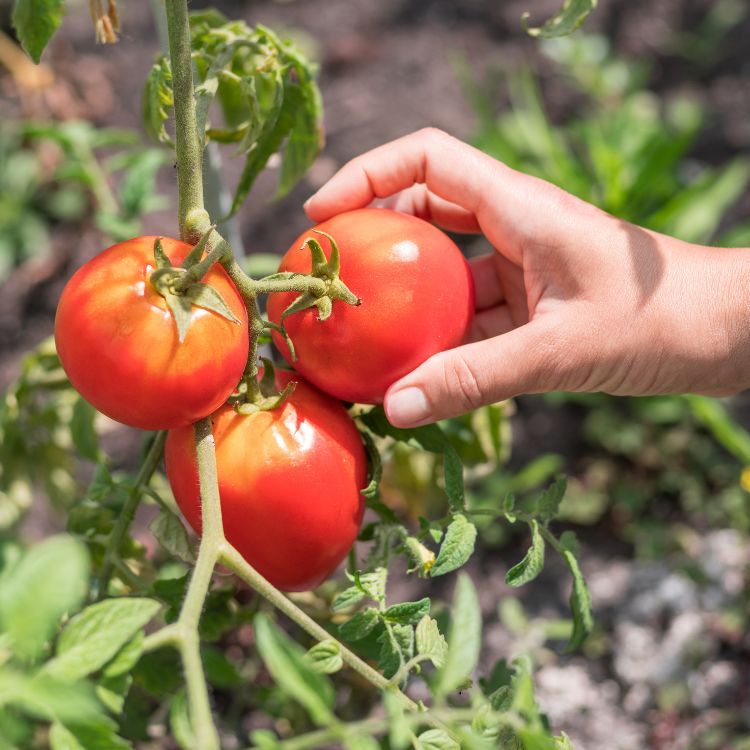
It’s not just about growing your tomatoes; it’s about knowing when to pick them. Harvest time is crucial. You want to pick your tomatoes when they’re at their peak of ripeness for the best flavor. Look for a deep, even color, whether it’s red, pink, yellow, or even black. The fruit should feel slightly soft to the touch, and it should come off the vine easily.
Recognizing Peak Ripeness
Tomatoes ripen from the inside out, so color is your best clue. When they’re the right color all over, they’re likely ripe. Another tip is to check the bottom of the fruit; it should have a slight give when it’s ready to be picked. But don’t wait too long—overripe tomatoes can attract pests and spoil quickly.
Harvest Techniques to Extend Freshness
When you harvest, be gentle. Use two hands—one to hold the fruit and the other to snip it with a pair of garden scissors or to twist it off carefully. This prevents damaging the plant and the fruit. And don’t wash your tomatoes until you’re ready to use them; keeping them dry extends their shelf life.
Secret #8: Leveraging Companion Planting
Companion planting is like matchmaking for plants. Some plants get along great and help each other out, while others should be kept apart. Tomatoes, for instance, love being near basil, which can improve their flavor and repel pests. But keep them away from potatoes and fennel, which can inhibit their growth and attract diseases.
Companions for Pest Prevention and Growth Boosting
Here are some companions that can help your tomatoes thrive: to learn more, explore these top tomato growing tips.
Basil repels flies and mosquitoes and may improve flavor.
Marigolds deter nematodes and other pests.
Calendula attracts beneficial insects and adds beauty to your garden.
Plants to Avoid in the Tomato Garden
Just like in life, some relationships are best avoided. Keep tomatoes away from:
Brassicas like cabbage and broccoli, which can stunt tomato growth.
Potatoes, which can share blight—a devastating disease for tomatoes.
Fennel, which releases substances that can inhibit tomato growth.
Secret #9: Season Extending Strategies
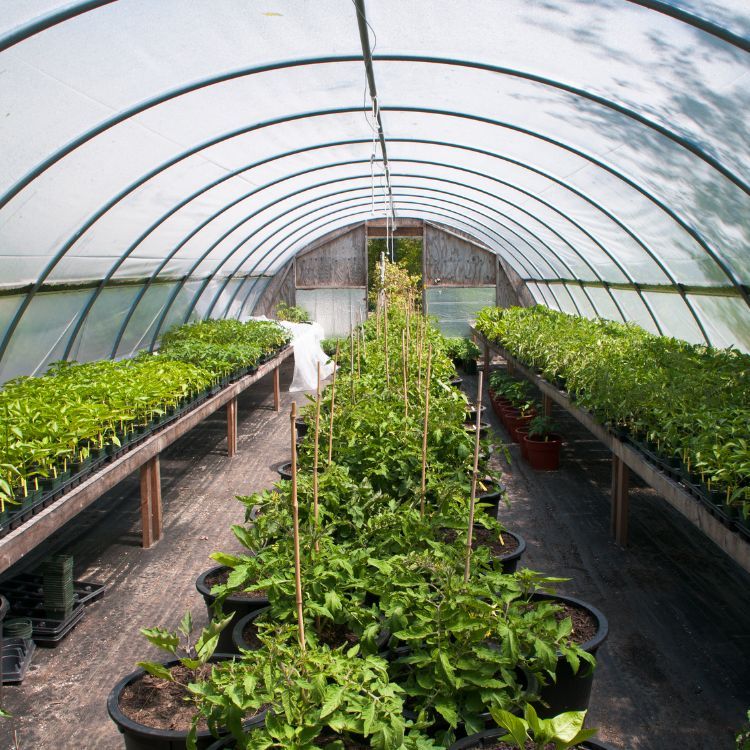
If you’re keen on getting the most out of your tomato season, think about extending it. Start your plants early indoors or in a greenhouse to get a jump on the season. As the weather cools, protect your plants with cloches or row covers to squeeze in a few more weeks of growth.
Getting an Early Start with Greenhouses or Cold Frames
Greenhouses and cold frames are like training wheels for young plants. They protect your tomatoes from the chill while letting them bask in the early spring sun. This gives you a head start, leading to earlier and potentially larger harvests.
Late-Season Protection for Tomatoes
When autumn’s chill arrives, it’s not necessarily game over. Use floating row covers or build a simple hoop house to keep the frost at bay and extend your harvest. Every extra day of growth can mean more tomatoes for your table.
Secret #10: Yearly Crop Rotation for Soil Health
Crop rotation is like giving your soil a year-long vacation. By changing where you plant your tomatoes each year, you help prevent the buildup of diseases and pests in the soil. Plus, it’s a chance to replenish the soil with different nutrients, depending on what you plant.
Benefits of Crop Rotation
Rotating crops can:
Reduce the risk of soil-borne diseases.
Break pest life cycles.
Improve soil structure and fertility.
How to Plan Your Rotations
Think of your garden in sections and rotate your crops in a cycle. If you planted tomatoes in one spot this year, don’t plant them there again for at least three years. Instead, follow them with a leafy green or a root vegetable. This keeps the soil balanced and your plants healthy.
Frequently Asked Questions
How Deep Should I Plant Tomato Seedlings?
Plant them so that two-thirds of the plant is buried, leaving only the top leaves above the soil. This encourages a strong root system and a sturdy plant.
Should I Prune Tomato Plants and If So, How?
Yes, prune your tomato plants. Remove the suckers—the little shoots that grow in the joints of branches—to focus the plant’s energy on producing fruit. Also, remove any leaves touching the soil to prevent disease.
Can Tomatoes Grow in Partial Shade?
Tomatoes can grow in partial shade, but they won’t be as productive or flavorful as those grown in full sun. Aim for a minimum of 7-8 hours of direct sunlight for the best results.
What Are the Best Organic Fertilizers for Tomatoes?
Look for organic fertilizers with a balanced mix of nitrogen, phosphorus, and potassium. Composted manure, bone meal, and cottonseed meal are great options.
Why is Crop Rotation Important for Tomatoes?
Crop rotation helps prevent diseases and pests that can build up in the soil, and it ensures that the soil remains rich in the different nutrients that various plants need.







Leave a Reply